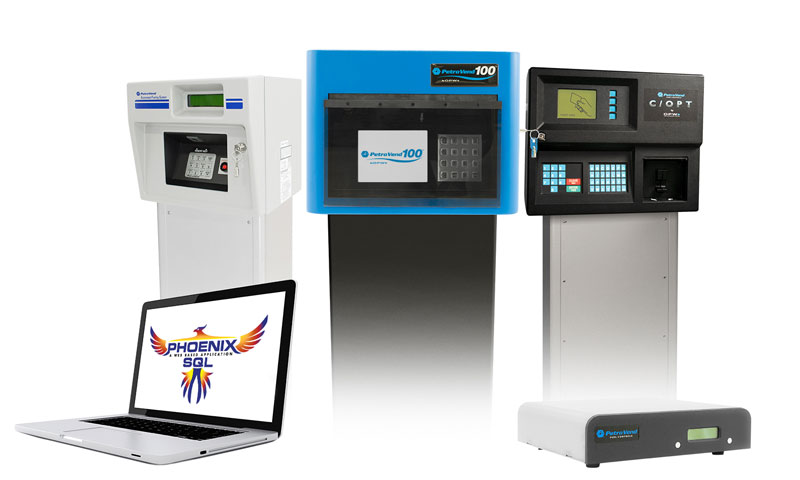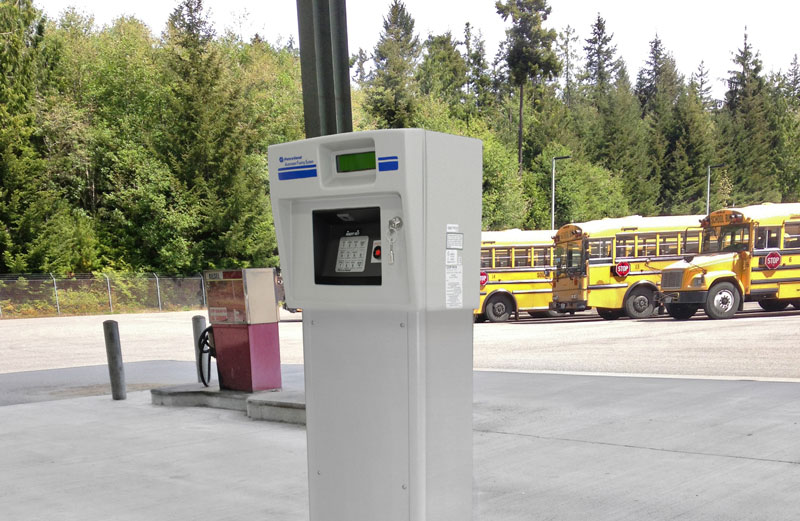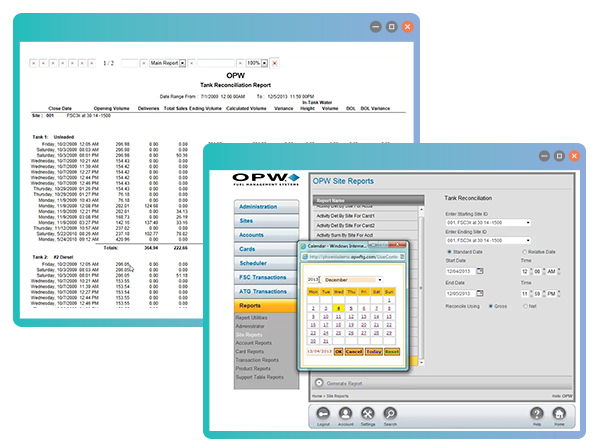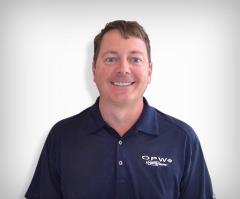Cardlock Systems Deliver a Number of Cost-Saving Advantages and a Few Challenges to Unattended Fuel Sites
For some Canadian fleet managers, making the leap to unattended fueling feels like putting the security of one of their most expensive assets — their fuel —in the hands of a nameless, faceless robot. But for many fuel site operators who already utilize a technology solution to authorize and track fueling, the thought of NOT having a cardlock system is the scarier scenario.
In the summer of 2014, Canadian fuel prices hit their highest rates since 2008. With significant volatility plaguing the oil market, erratic fuel prices are undermining the efficacy of fuel budgets. Amid these unpredictable economic conditions, inquiries about cardlock systems that help safeguard fuel inventories are on the rise. For those operations considering unattended fueling as part of their future, here is a look at the benefits and drawbacks of hosting a cardlock system.

OPW Fuel Management Systems’ cardlock solutions, including the K800™ Hybrid, Petro Vend 100® and C/OPT™ fuel island terminals, Phoenix® Fuel Management Software and FSC3000™ Fuel Site Controller shown here, provide 24-7 fuel control and streamlined data reporting for unattended fuel sites.
PROS
Unattended fueling provides many benefits to private fleet managers and fuel marketers, including — but certainly not limited to — lower operating costs, reduced inventory losses and maximum uptime. These benefits are made possible through a technology solution that administers authorization and tracking of fueling by an account or user basis. This is typically accomplished through the use of an authorization device, such as a card, or a keyed-in entry. This process “approves” the distribution of fuel, and then assigns it to a specific person, vehicle, department or organization.
The technology also automates data recording procedures that would otherwise be handled manually by site staff, or in some very rare instances of the “honor system” that still exist at very small fuel sites, the drivers themselves. These benefits, though, only scratch the surface of the advantages that unattended fueling technologies provide to Canadian fleet managers and fuel re-sellers. Here’s a more in-depth look into the specific benefits of unattended fueling:
Maximize uptime and reduce operating costs. Two of the greatest benefits of unattended fueling are the ability to enable fueling 24 hours a day, seven days a week, without having to pay retail prices or the additional expense of staffing an attendant to authorize, track and report the fleet’s fueling activities. In addition, many cardlock systems provide efficiencies beyond fuel management by integrating with other systems such as gate access systems, fleet management software and more.

OPW Fuel Management Systems’ K800™ Hybrid helps private fleets, such as the school transportation fleet shown here, control access to fuel and optimize the scheduling of preventive maintenance.
Private fleets that host their own unattended fuel site also eliminate inefficiencies and safety issues resulting from stops at public fuel sites. Drivers no longer need to navigate congested forecourts with oversized vehicles, nor lines of C-store customers waiting to pay for their snacks and lottery tickets. In addition, automated fuel management systems reduce data errors, which creates significant bookkeeping efficiencies.
Reduce misuse of fuel. Fuel is one of the largest expenses facing any fleet. Canadian fleet managers that don’t control their fuel through an automated technology solution put their costly fuel inventories at risk. Here’s why: fuel theft and abuse of fueling privileges are difficult — if not impossible — to prevent and mitigate without the assistance of a cardlock system.
Many fuel control systems for unattended fuel sites not only restrict access to authorized users, they validate the driver’s fuel usage. For instance, cardlock systems from Hodgkins, IL-based OPW Fuel Management Systems can be configured to require drivers to enter odometer readings each time they fuel. Administrators who configure their system to enforce mileage reasonability restrictions will help administrators flag when company resources are being misused.
The ability to set quantity restrictions and to pull “exception” reports that identify fueling outside the scope of those restrictions, allow Canadian fuel managers to intervene and halt future incidents of theft. In addition, cardlock systems that are linked to an automatic tank gauge can record every drop of fuel that goes in and out of fuel storage tanks. As a result, they provide a verifiable record of deliveries, which allows site operators to substantiate shortages. Finally, because cardlock systems can integrate with gate controls, they also limit who can access the fuel site, which enhances the security of the fleet yard.
Enhance other aspects of your operation through systems integration. Because many of today’s cardlock systems have the ability to integrate with other on-site systems, unattended fuel sites are able to maximize their original equipment investment.
For instance, OPW’s unattended systems can push data to fleet management programs. This not only optimizes the scheduling of preventive maintenance, it provides visibility into vehicle fuel efficiency issues that may need to be corrected. By streamlining the scheduling of preventive vehicle servicing, potential problems are prevented, vehicle availability is maximized and the service life of fleet vehicles is extended.
Improve bookkeeping and tighten budgets. While it may seem somewhat counter-intuitive, fleet yards that have an attendant on-site who is charged with managing access to fuel actually have less visibility into critical inventory and fuel usage data than sites that utilize a technology solution to manage fueling.
Today’s cardlock systems capture a detailed amount of fuel-usage and vehicle data. The cardlocks can connect with fuel management software programs or export the data for use in accounting software to be used for bookkeeping and data analytics. The data provides administrators much greater — and more accurate — visibility into actual consumption and vehicle performance issues. Armed with this information, a fleet manager can streamline bookkeeping procedures (imagine being able to bill individual user departments within a fleet division) and budget more accurately, in less time.
Create additional revenue streams. By making the leap to unattended fueling, some operations have increased operating efficiency. For example, some sites have expanded their pool of cardlock users to include drivers from nearby fleets. This ability to re-sell fuel allows the cardlock operator to recoup some of their fuel costs. Likewise, fuel sites that join a cardlock fueling network, such as Pacific Pride or CFN, not only increase the number of vehicles that can fuel at their site, they effectively create a whole new customer base.
For example, a small proprietary network of 1,000 users can expect traffic from only those 1,000 users. A 1,000-user site that joins a cardlock fueling network can expect traffic from its original 1,000 users as well as from other members of the cardlock network. This co-op approach to fleet fueling creates a win-win situation for both the original cardlock site and the network.
CONS
Some Canadian fuel site operators hesitate to pursue unattended fueling due to unease about technology solutions or perceived liability issues. However, fuel management equipment manufacturers have responded by designing user-friendly systems and engineering solutions into cardlocks that address many of the liability concerns. Here are a few of the most common challenges unattended fuel sites face.
Safety management is challenging. Even at fuel sites with the highest level of safeguards in place, accidents happen — either due to human error or equipment malfunctions. Unfortunately, incidents of a more malevolent nature are also not uncommon. As a result, safety management can be a challenge at Canadian unattended fuel sites.

Cardlock systems, such as OPW’s C/OPT™ Fuel Control System pictured here, help fleet administrators carefully manage their fuel assets by facilitating authorization of — and providing accountability for — fuel usage.
With safety and environmental incidents, time is of the essence. Without an attendant on-site to monitor fuel dispensers, all manner of hazardous incidents — ranging from a major fire to a minor spill — can go unresolved. A vehicle could strike a pump or an automatic nozzle might not shut off properly, or a vengeful driver might just decide to lay a nozzle down on the ground, creating a hazardous and costly fuel spill.
Fortunately, some cardlock manufacturers are engineering requisite safety training into their systems that help sites meet Canadian fire safety regulations and improve responsiveness should an incident occur. For example, cardlock systems from OPW utilize a “registered bank card” feature that will only authorize fueling for users that the system identifies as having completed training on basic safety protocols (emergency shut-off procedures, procedures for responding to a fire, etc.). Some systems even facilitate the training right through the cardlock terminal itself, making drivers accountable for the information they learn during the training.
Sites are not immune to criminal activity. While cardlock systems certainly deter criminal activity, they can’t eliminate it altogether. Without an attendant on-site to keep an eye out for suspicious activity or to discourage criminals from taking advantage of the unmanned site, the fuel site is vulnerable to theft and other illicit behavior.
For instance, thieves have been known to break into dispensers and tamper with pulsers in order to manipulate the pump into dispensing more fuel than a cardlock system has authorized it to fuel. Other thieves go directly to the source, pulling fuel right out of the tank.

Today’s cardlock systems significantly simplify data management by streamlining bookkeeping and reporting procedures through advanced fuel management software programs such as OPW’s Phoenix® Fuel Management Software.
Card fraudsters also take advantage of un-manned fuel sites, using them as testing grounds for stolen credit cards. It is not uncommon for credit card thieves to roll up to a fuel island terminal, swipe a handful of credit cards to see if their stolen cards will be authorized or declined. Fortunately, manufacturers are beginning to engineer preventive measures into their cardlock equipment, such as ZIP code authentication, that help to impede fraudulent activities. In addition, card skimmers are growing increasingly sophisticated. Currently, their penetration into cardlock operations has been somewhat limited in comparison to traditional retail sites (most fraudsters can only steal fuel at participating network sites so cardlock sites are inherently less attractive to data thieves).
Timely responses to equipment malfunctions can be compromised. Most fuel management equipment manufacturers engineer their cardlock devices to be as reliable and durable for as long as possible. Nevertheless, issues do arise, and this can be challenging for an unattended fuel site, where communication of an equipment problem — and a resolution — is sometimes delayed.
Fortunately, cardlock manufacturers have begun to engineer solutions into their systems that help mitigate those delays by alerting site operators to maintenance issues, ranging from a pump failure to a receipt printer that is low on paper. These alerts allow maintenance technicians to overcome one of the biggest perceived drawbacks of unattended fueling, and address issues at unmanned sites in a prompt and efficient manner.
For instance, some card networks pull statuses from the site controllers every couple of hours and look for exception reports. When the transactions are pulled, administrators can see the number of attempts to obtain fuel that ultimately failed and alert a site operator to check the equipment. In addition, some fuel site controllers will send a notification to a site operator if it detects a performance issue. These communications provide site operators visibility into the scope of the problem (is it an issue that needs to be addressed immediately, or can it wait until the next day?), help minimize site downtime, and at cardlock network sites, help maintain high levels of customer satisfaction.
Invest Now to Save Money Later
When fuel prices spike, every liter of fuel — and every loonie — counts. Although unattended fuel sites bring a handful of challenges due to their un-staffed nature, they also deliver a number of cost-saving and security benefits that, for most fuel sites, outweigh their shortcomings. With recent fuel prices trending lower than they were five years ago, and an uncertain economic climate ahead, forward-thinking fleet managers would be wise to weigh the pros and cons of unattended fueling in the context of their operation’s unique needs. A proactive fuel management decision now could mean the difference between a balanced budget and an unanticipated financial loss, which could impact operations or be experienced over long periods of time.

About the Author:
Bobby Hayes is the Domestic Sales Manager at OPW Fuel Management Systems in Hodgkins, IL. He can be reached at (770) 605-9611 or robert.hayes@opwglobal.com. OPW is a global leader in fully integrated fluid handling, management, monitoring and control solutions for the safe and efficient handling of critical petroleum-derived fluids. For more information, visit www.opwglobal.com.